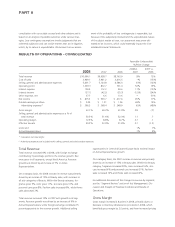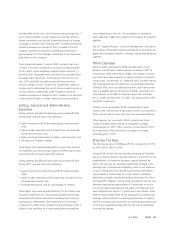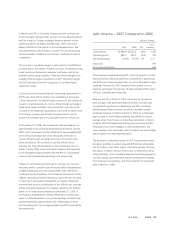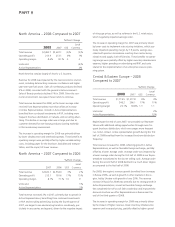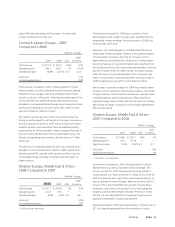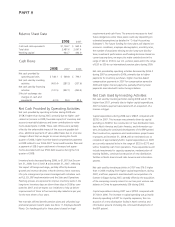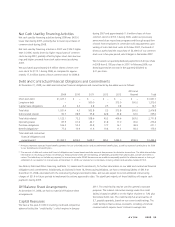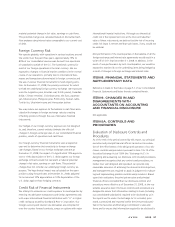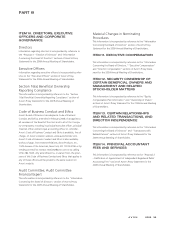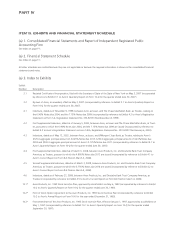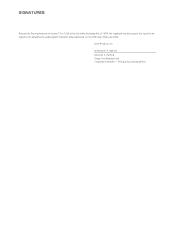Avon 2008 Annual Report Download - page 42
Download and view the complete annual report
Please find page 42 of the 2008 Avon annual report below. You can navigate through the pages in the report by either clicking on the pages listed below, or by using the keyword search tool below to find specific information within the annual report.PART II
(determined in relation to our consolidated pretax income and
interest expense) to equal or exceed 4:1. The credit facility also
provides for possible increases by up to an aggregate incre-
mental principal amount of $250.0, subject to the consent of the
affected lenders under the credit facility. At December 31, 2008,
there were no amounts outstanding under the credit facility.
We have a $1,000.0 commercial paper program. Under this pro-
gram, we may issue from time to time unsecured promissory
notes in the commercial paper market in private placements
exempt from registration under federal and state securities laws,
for a cumulative face amount not to exceed $1,000.0 outstand-
ing at any one time and with maturities not exceeding 270 days
from the date of issue. The commercial paper short-term notes
issued under the program are not redeemable prior to maturity
and are not subject to voluntary prepayment. The commercial
paper program is supported by our credit facility. Outstanding
commercial paper effectively reduces the amount available for
borrowing under the credit facility. At December 31, 2008, we
had commercial paper outstanding of $499.7.
We have a Japanese yen 11 billion ($122.0 at the exchange rate
on December 31, 2008) uncommitted credit facility (“yen credit
facility”), which expires in August 2009. Borrowings under the
yen credit facility bear interest at the yen LIBOR rate plus an
applicable margin. The yen credit facility is available for general
corporate purposes, including working capital and the repay-
ment of outstanding indebtedness. At December 31, 2008,
$102.0 (Japanese yen 9.2 billion) was outstanding under the yen
credit facility.
In March 2008, we issued $500.0 principal amount of notes
payable in a public offering. $250.0 of the notes bear interest at
a per annum coupon rate equal to 4.8%, payable semi-annually,
and mature on March 1, 2013, unless redeemed prior to ma-
turity (the “2013 Notes”). $250.0 of the notes bear interest at a
per annum coupon rate of 5.75%, payable semi-annually, and
mature on March 1, 2018, unless redeemed prior to maturity
(the “2018 Notes”). The net proceeds from the offering of
$496.3 were used to repay outstanding indebtedness under our
commercial paper program and for general corporate purposes.
In August 2007, we entered into treasury lock agreements (the
“locks”) with notional amounts totaling $500.0 designated as
cash flow hedges of the anticipated interest payments on $250.0
principal amount of the 2013 Notes and $250.0 principal
amount of the 2018 Notes. The losses on the locks of $38.0
were recorded in accumulated other comprehensive loss. $19.2
and $18.8 of the losses are being amortized to interest expense
over five years and ten years, respectively.
At December 31, 2008, we were in compliance with all cove-
nants in our indentures (see Note 4, Debt and Other Financing).
Such indentures do not contain any rating downgrade triggers
that would accelerate the maturity of our debt. However, we
would be required to make an offer to repurchase the 2013
Notes and 2018 Notes at a price equal to 101% of their
aggregate principal amount plus accrued and unpaid interest in
the event of a change in control involving Avon and a
corresponding ratings downgrade to below investment grade.
ITEM 7A. QUANTITATIVE AND
QUALITATIVE DISCLOSURES ABOUT
MARKET RISK
The overall objective of our financial risk management program
is to reduce the potential negative effects from changes in
foreign exchange and interest rates arising from our business
activities. We may reduce our exposure to fluctuations in cash
flows associated with changes in interest rates and foreign
exchange rates by creating offsetting positions through the use
of derivative financial instruments and through operational
means. Since we use foreign currency rate-sensitive and interest
rate-sensitive instruments to hedge a certain portion of our exist-
ing and forecasted transactions, we expect that any loss in value
for the hedge instruments generally would be offset by increases
in the value of the underlying transactions.
We do not enter into derivative financial instruments for trading
or speculative purposes, nor are we a party to leveraged
derivatives. The master agreements governing our derivative
contracts generally contain standard provisions that could trigger
early termination of the contracts in certain circumstances,
including if we were to merge with another entity and the
creditworthiness of the surviving entity were to be “materially
weaker” than that of Avon prior to the merger.
Interest Rate Risk
Our long-term, fixed-rate borrowings are subject to interest rate
risk. We use interest rate swaps, which effectively convert the
fixed rate on the debt to a floating interest rate, to manage our
interest rate exposure. At December 31, 2008 and 2007, we
held interest rate swap agreements that effectively converted
approximately 50% and 30% of our outstanding long-term,
fixed-rate borrowings to a variable interest rate based on LIBOR,
respectively. Avon’s total exposure to floating interest rates at
December 31, 2008, and December 31, 2007, was approx-
imately 65% and 60%, respectively.
Our long-term borrowings and interest rate swaps were analyzed
at year-end to determine their sensitivity to interest rate changes.
Based on the outstanding balance of all these financial instru-
ments at December 31, 2008, a hypothetical 50-basis-point
change (either an increase or a decrease) in interest rates prevail-
ing at that date, sustained for one year, would not represent a


